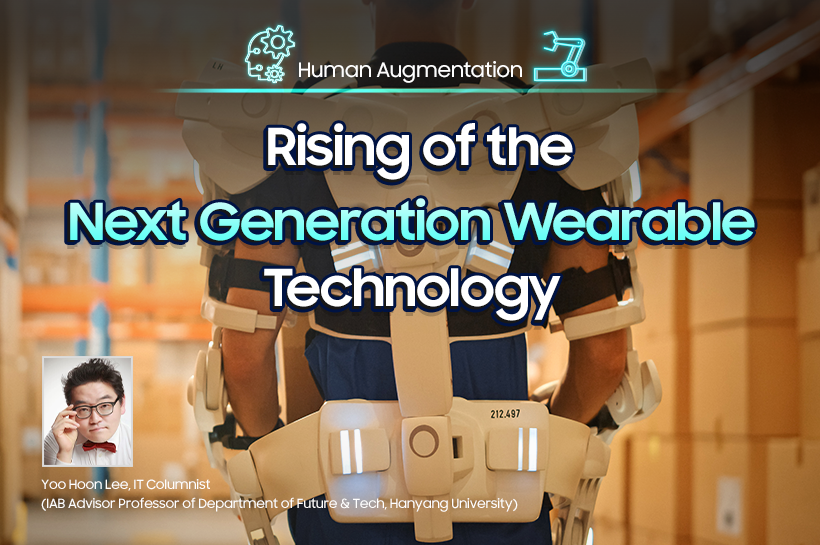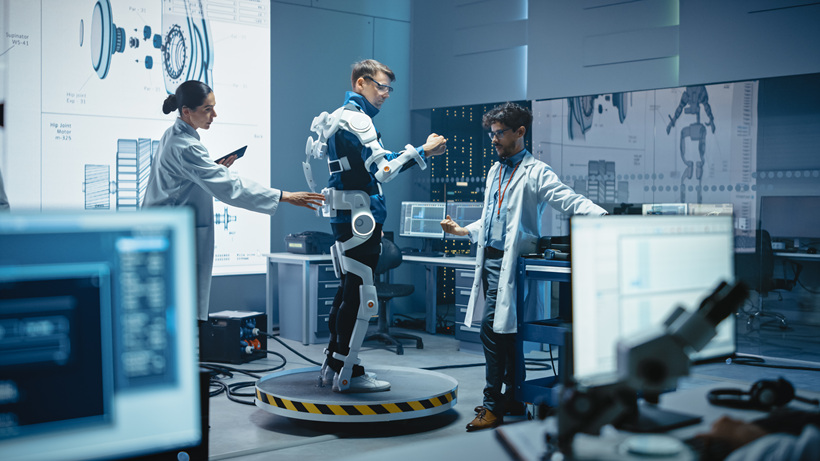
Is there some sort of obligation for science to recreate visualizations of future technology in movies? Self-driving cars, smartphones, holograms, flying cars are some of the various research pursued based on human imagination. Wearable robots and powered exoskeletons are no exception: What we’ve seen in movies like ‘Aliens (1986), ‘Iron Man (2008)’, and ‘Edge of Tomorrow (2014)’ are all becoming part of our reality today.
Origins of Wearable Technology: Space Exploration

Wearable technology blossomed into existence during the space race era in the United States in the 1950s, after World War II. Since no one had any idea what to expect in space during the early days of exploration, one of the key suggestions for astronauts to wear was an exoskeleton. Under the assumption that astronauts would be wearing hard suits, scientists contemplated inhibiting muscle movement by adding exoskeletons over space suits. Still, that idea dissipated as soon as soft suits were chosen to be space travel.

Research on exoskeleton halted, but it became a source of inspiration for many science fiction writers. 'Starship Troopers', written by Robert A. Heinlein, was a best-selling military science fiction novel introducing the idea of soldiers fighting an interstellar war wearing exoskeletons. The novel’s popularity impacted the concept ‘Man Amplifier*’ and later motivated General Electric (GE) to build a practical powered exoskeleton ‘Hardiman’. Based on the Hardiman Project Report written by the lead engineer Ralph Mosher, robot-like human productivity amplification allowing people to work smarter was apparent anticipation behind the effort.
* An exoskeleton controlled by an internal exo-Motion Capture with a human operator
Hypothesizing is easy, but bringing ideas to fruition is always a challenge. Prototyping and developing concepts raise issues unthought of before. That is why conceptual models are used to validate usability. Wearable technology also needed justification as to whether it was controllable and not harmful towards people. Like many other ideas, wearable devices failed concept validation. Although research had been conducted intermittently, there were no existing commercialized products. Instead, it inspired creative works depicting soldiers at war with exoskeletons and human-controlled robots.
DARPA’s Revival of Wearables
In 2001, the Defense Advanced Research Projects Agency (DARPA) revisited the potential of wearable technology research. Heavy shouldering soldiers were becoming problematic due to the increasing weight of military equipment. Initial research program participants behind DARPA’s wearable device received $50 million in the five years. Two companies ultimately reaped success through the initiative: Sarcos, which previously operated as the robotics division of American defense contractor Raytheon, developed Guardian XO full-body, and Lockheed Martin developed the Human Universal Load Carrier (HULC).

▲ Lockheed Martin’s HULC helps soldiers in combat carry a load of up to 200 pounds at a top speed of 10 miles per hour for extended periods of time.
Wearable technology research was not uniquely pursued in the United States. Companies like the Hybrid Assistive Limb (HAL) in Japan were also investing in innovation. However, tangible outcomes came from the efforts pursued by the DARPA project participants. Once key industry accomplishments took place around 2010, other countries and companies jumped in as well-some converted military research results for more commercial use. Companies considering robotics as future technology like Samsung Electronics also started research development. This led to a transformative movement from a human augmentation-centric phase to the next-generation wearable device era.
What is the key difference between existing wearable technology vs. next-generation wearables? First of all, there are far more supportive wearables designed to assist human movement than power-enhancing types. Secondly, soft wearable robots/low-power wearables that are lightweight and inexpensive are distributed first, unlike the initial assumption about market needs. Even though people dreamt of an Iron-Man exoskeleton, what they actually needed was an innovation that would take away the burden of human workload like how electric bicycles changed our daily lives; The new technology had to be convenient, easy to wear, and affordable. In other words, the technology we can operate “reliably” today is limited to reducing human workloads that are more practical.
Implementation of Wearable Technology

Building an 'Iron Man' suit will take time, but wearable research has rapidly grown in the past 20 years by developing materials and integrating recent innovations in smart devices and electric vehicle technology. There are three key technologies needed for wearables: (1) an actuator that transmits forces, (2) a control interface that controls signals, and (3) data collection/utilization.

Motors and artificial muscles are mainly used for actuators. For artificial muscles, fabric muscle sheets and spring-based or pneumatic driven passive types are widely used, but active types powered by electricity could be implemented. Interface technology defines and reacts to user experience. Tactile sensors, air pressure, bioelectricity, and speech recognition are in use. Last but not least, collecting user data and analyzing them with artificial intelligence to help improve the user experience will be expected. Personalized wearables that adjust to each individual will most likely lead the future of this exciting technology.
Non-military use of wearable technology can be categorized into three parts: (1) Commercial, (2) Medical, and (3) Consumer wearables.
Commercial wearables are already widely used, especially in overhead environments where workers lift their arms for an extended period of time. Hyundai Motor Group’s VEX(Vest EXoskeleton) is spring-based passive robotics that only weighs 2.5kg and can lift a 3kg tool without feeling the weight. There is demand in construction sites as well as logistics due to increased demand caused by COVID19. ATOUN Inc., a Panasonic group company, developed ATOUN MODEL Y, motor-powered wear. Weighing 4.5 kg, ATOUN MODEL Y mainly supports the waist and can be used for up to eight hours. Using it can reduce Musculoskeletal Disorders (MSD) that frequently occur in industrial sites. Introducing wearables to farmers in need is also being discussed lately.
Medical wearables are commonly used to assist disabled people with rehabilitation, as demonstrated by the Cybathlon*. For example, Angel Legs M (Class II medical device) developed by Angel Robotics helps patients with incomplete lower extremity paralysis. It is used in welfare agencies, hospitals, and rehabilitation facilities. ReStore™ exosuit (ReWalk Robotics, Ltd) is the first soft robotic exosuit cleared by the FDA intended for the use in the rehabilitation of individuals with lower limb disabilities due to stroke. Lastly, during CES 2020, Samsung Electronics unveiled an exoskeleton called Gait Enhancing & Motivating System (GEMS) designed to assist with everyday walking. Based on user needs, it can be worn on hip joints, knees, or ankles. It is said that by wearing the soft-robotic glove Ironhand® battery-powered (Sweden-based company Bioservo’s wearable technology), users can enhance their strength up to 20%.
* Held every 4 years, it is an international competition in which people with physical disabilities compete against each other to complete everyday tasks using assistive technologies
Wearable technology is comparable to electric bicycles: You could just ride a normal bike, but electric bikes help you pedal faster. The high price tag limits supply, but there are so many possibilities with wearables. With less physical burden, more people would be able to work in industrial sites efficiently, and the aging workforce could benefit from the assistance. Most importantly, the existence of wearable technology makes our society ideal for people to grow and live at an old age. Given that wearable technology is still in its infancy with a promising future ahead, it is still crucial to navigate the early stages of its malfunctions or exploits.




